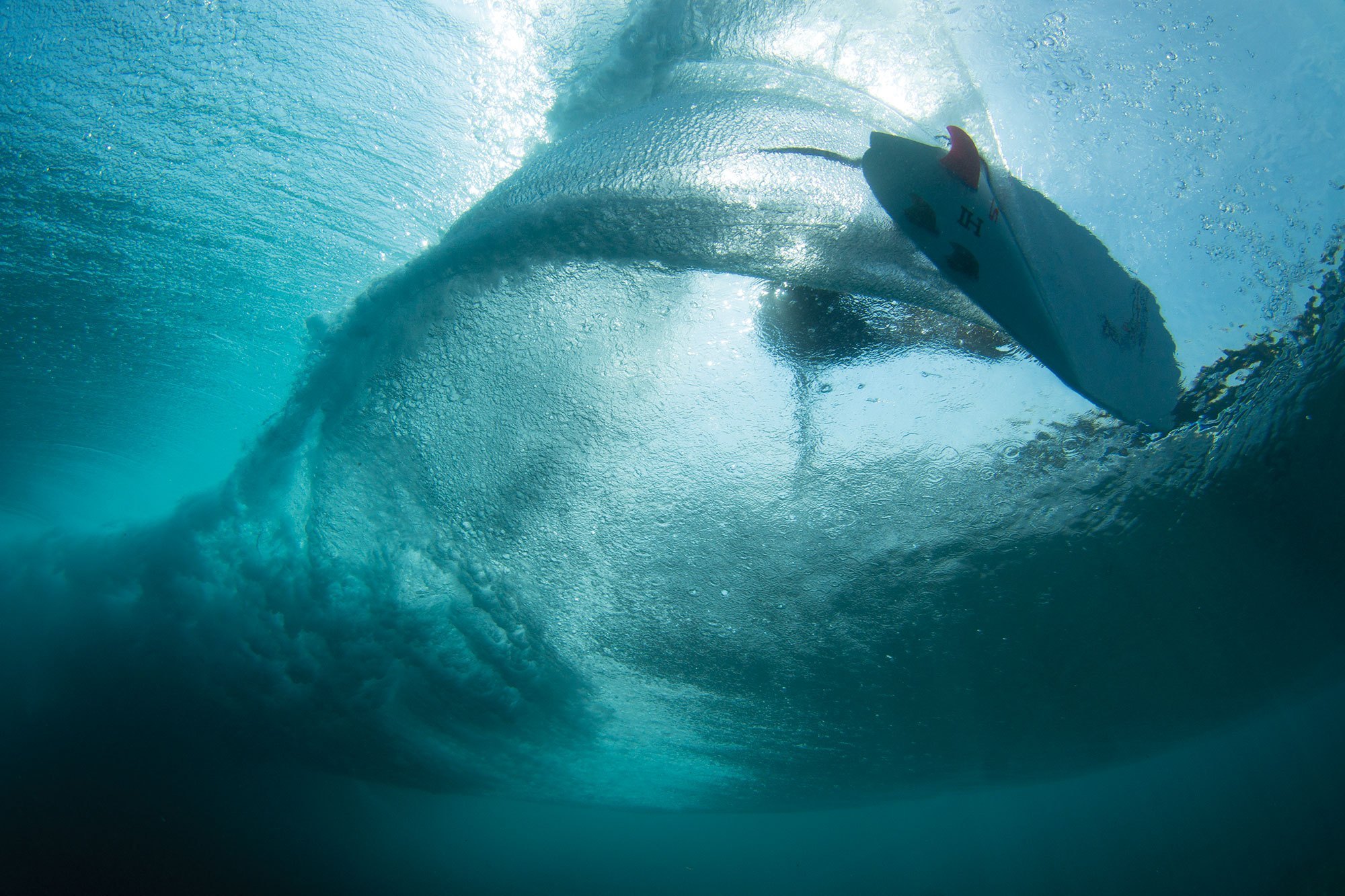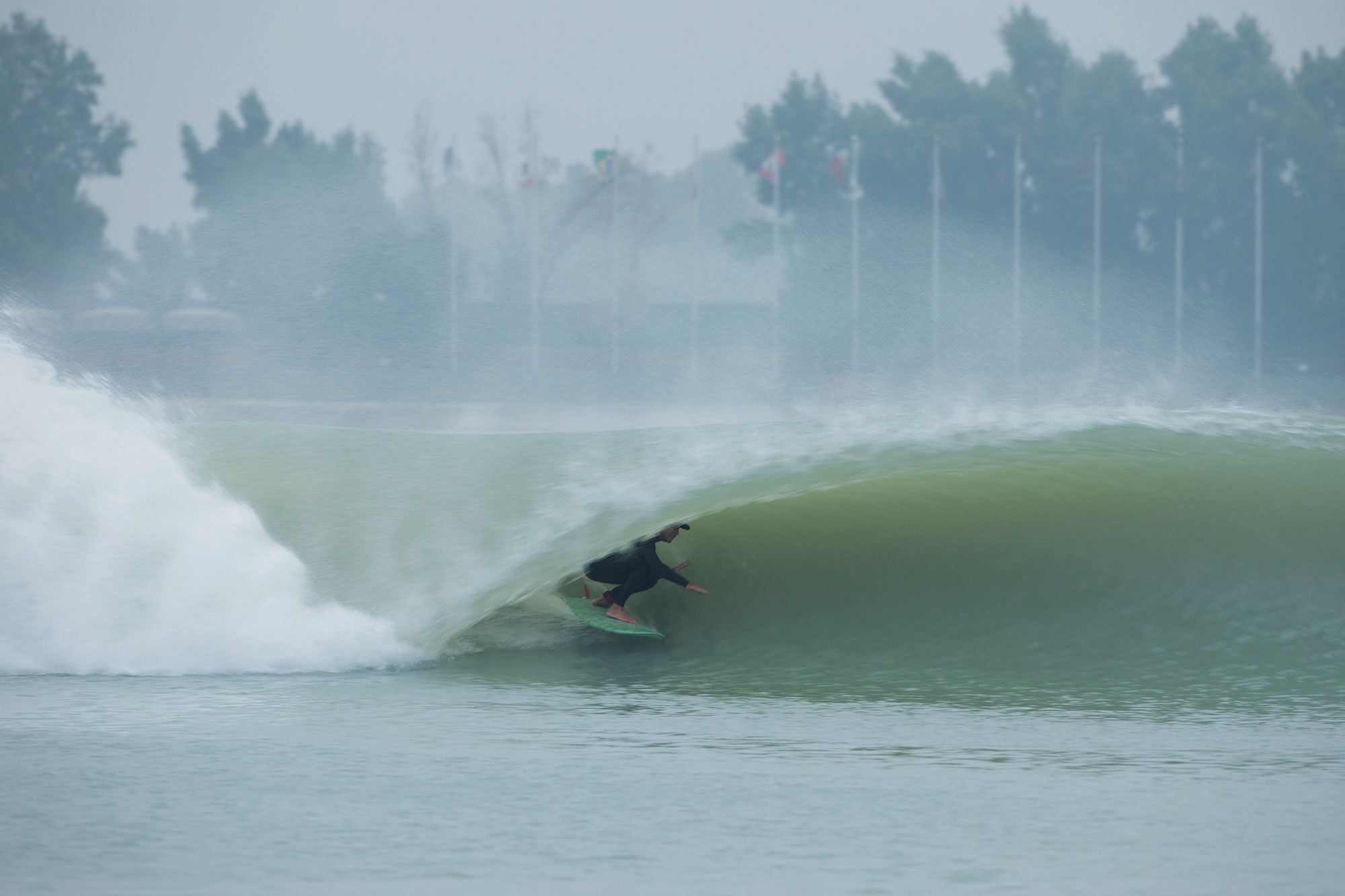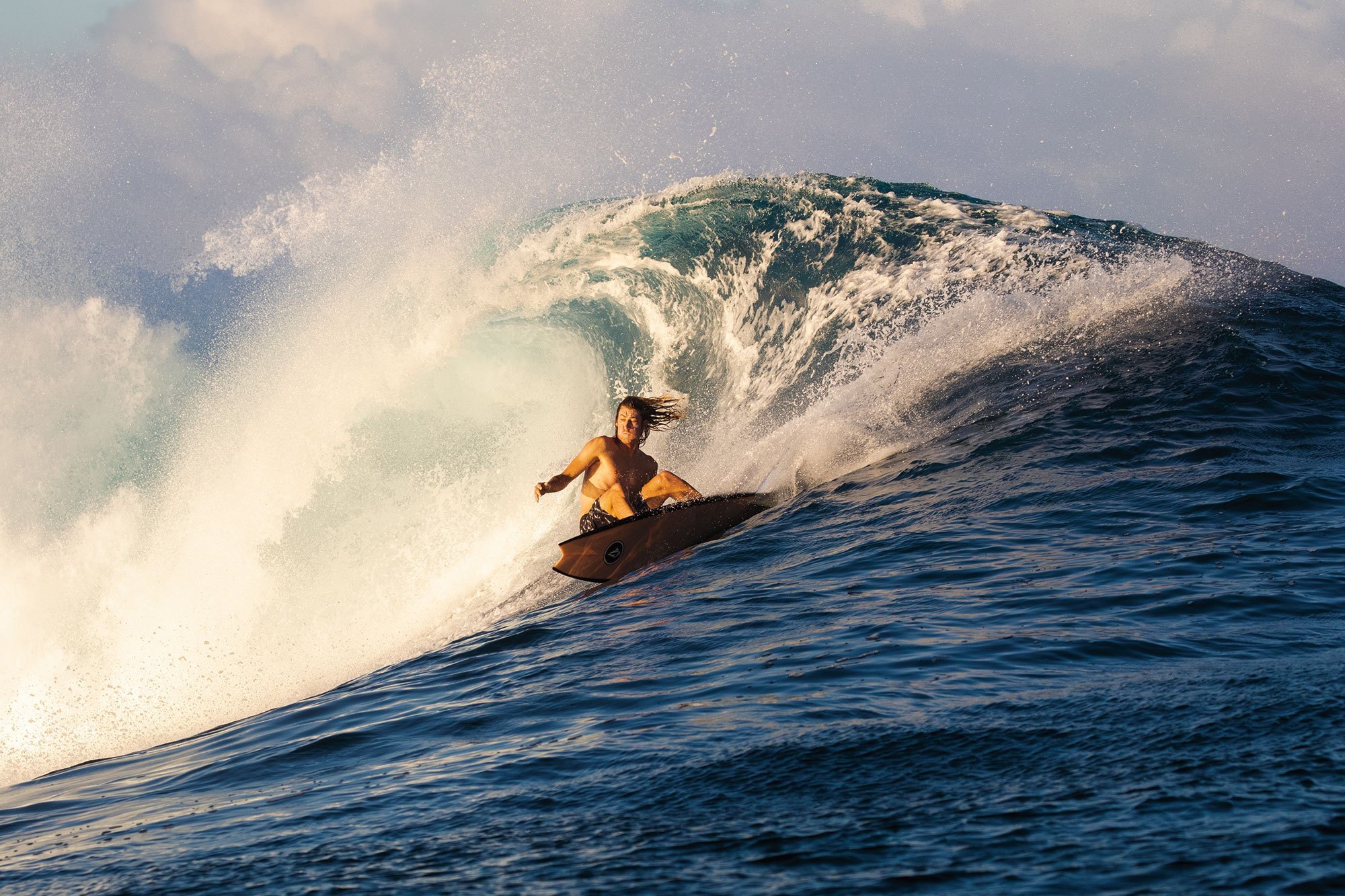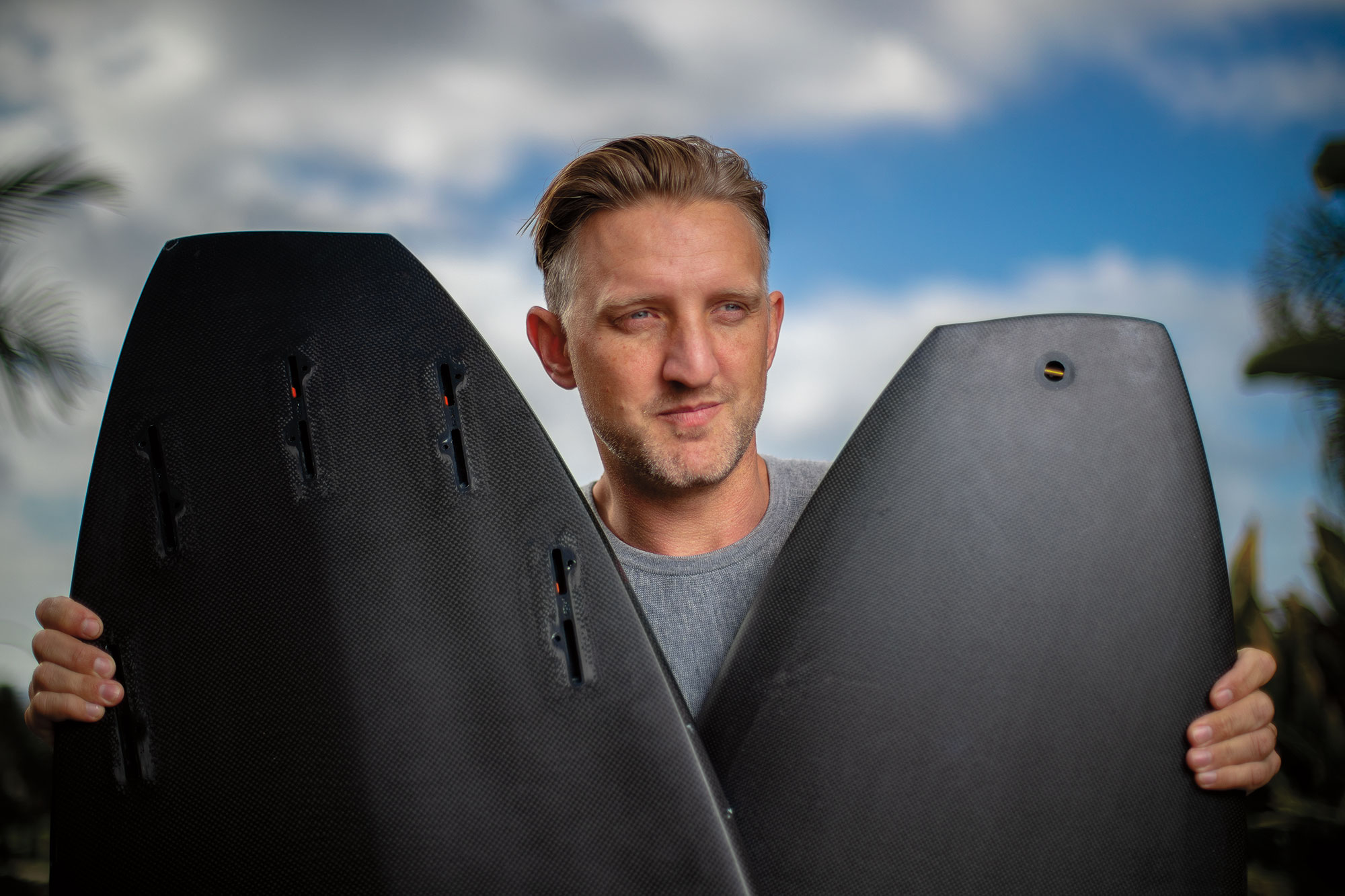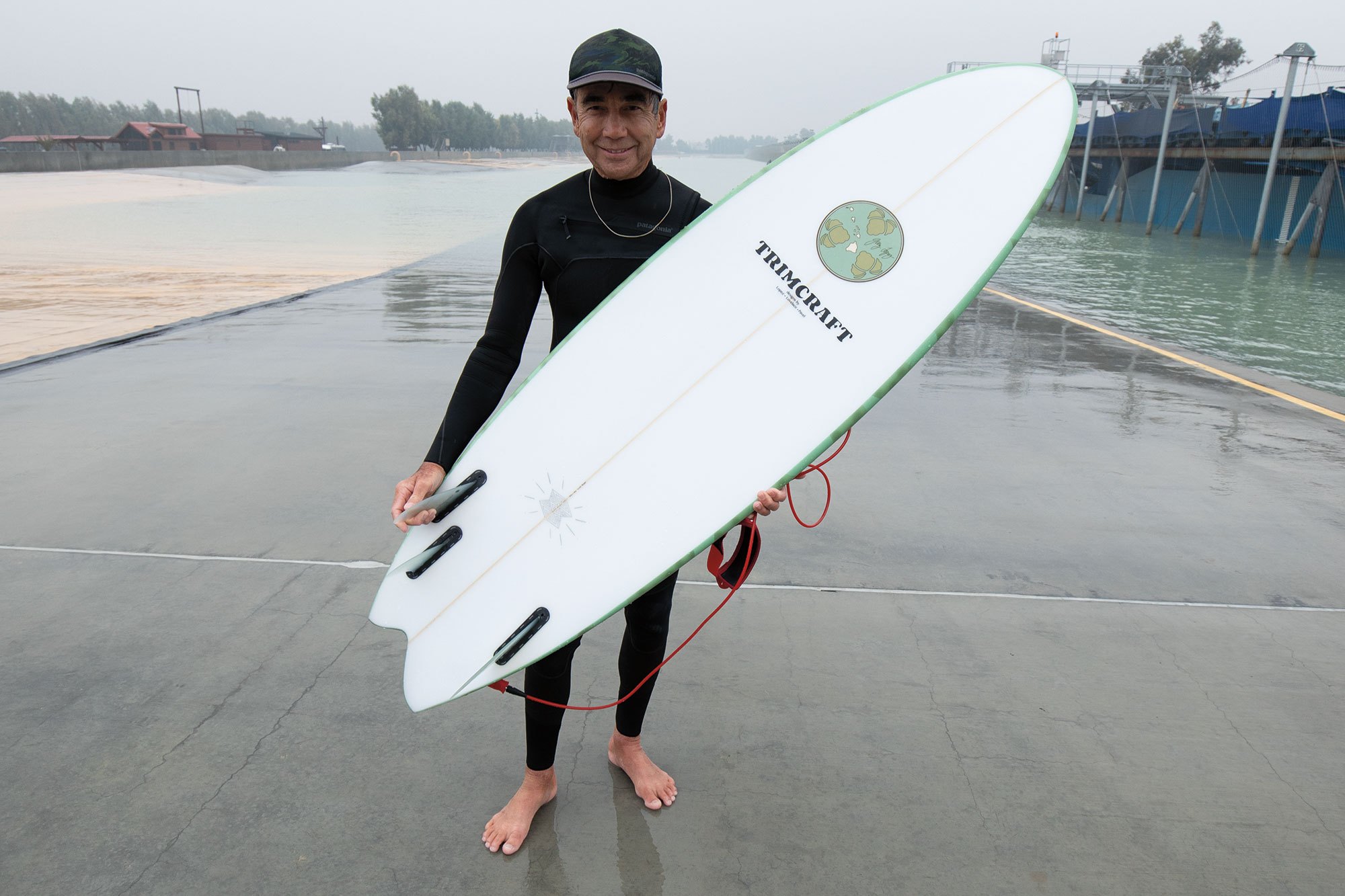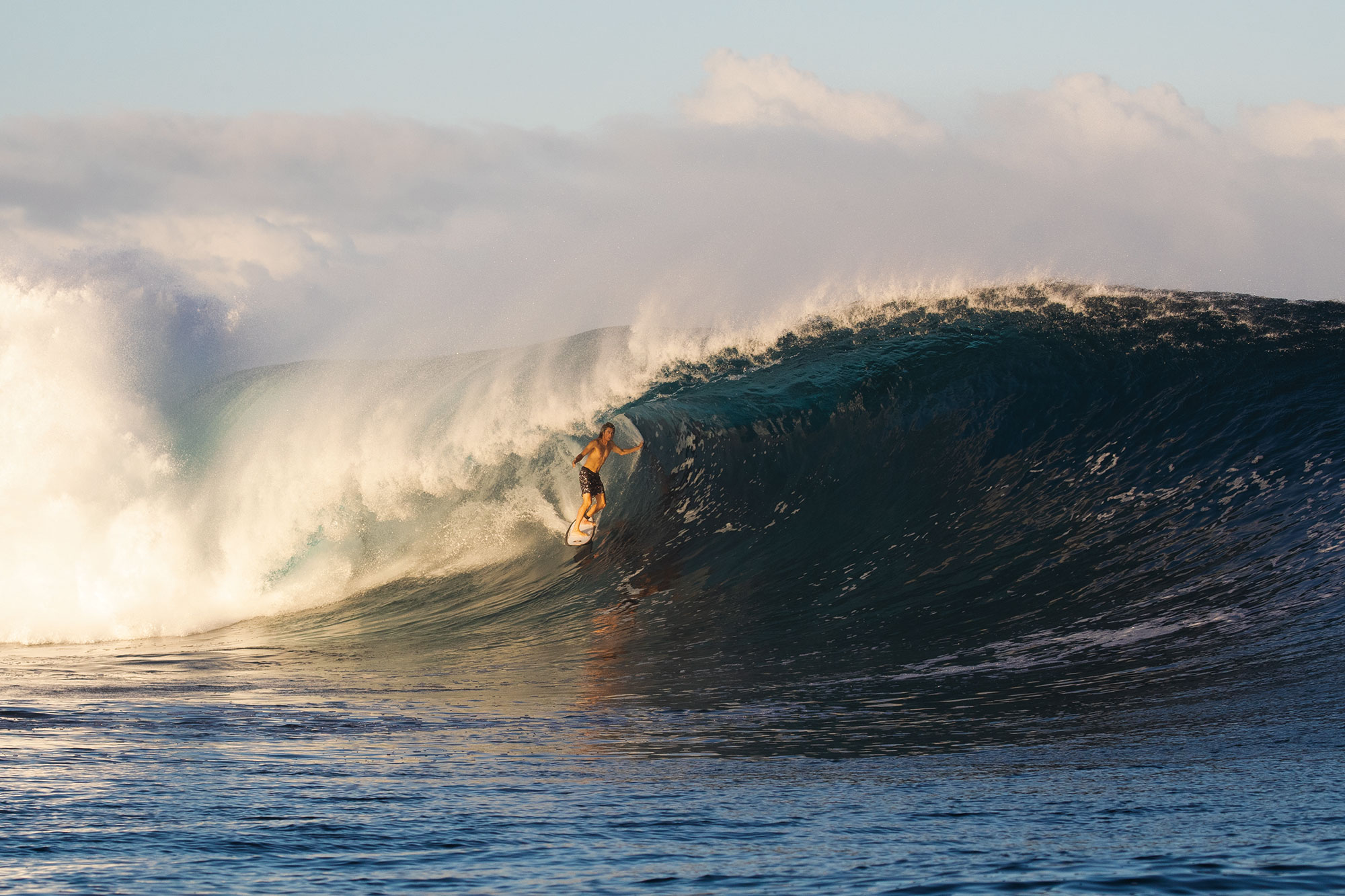[This feature originally appeared as “A Crooken Path” in SURFER’s spring 2020 issue. If you don’t already get the mag delivered to your door, click here to subscribe.]
DEEP within the DNA of nearly every surfboard ever made, there has been a single unchanging rule: The Rule of Symmetry. It’s a sacrosanct law that has guided the hands and planers of board builders for the last hundred plus years of modern surfing. Longer, even, if you include the ancient Polynesian craftsmen carving boards from koa wood using flaked stone. Lengthwise from the center, their boards were beautifully symmetrical from tip to tail, save for knots and grain in the wood—a task devilishly difficult to accomplish with rudimentary tools. That their boards were in balance physically and aesthetically clearly mattered to the world’s first shapers. Even the Peruvian artisans weaving their reed surfboats called Caballito de Totora, thousands of years ago, were careful to shape their craft to a pleasing symmetry. Regardless of length, width, thickness, bizarre bottom contours, performance characteristics or eccentric fin placement, the rule of symmetry has always applied to surfboards—still does today, in fact.
Aesthetically, it’s irresistible. The very notion of human beauty is oriented around symmetry—the more symmetrical the face, the more beautiful the person. Symmetry is balance. Our eye craves it. It’s deeply satisfying. Perhaps that genetic pull toward balance is why the same principles of symmetry apply to surfboard construction. As you set out to build one, it’s intuitive, natural: Make each side as the other. But, a wild question: What if everything we thought about this rule was wrong when it comes to surfboard building? What if the long-sought-after next phase of surfboard design, stagnant since the thruster was developed 40-ish years ago, is to reject the idea of symmetry altogether and to normalize what has until now been considered fringe? After all, the one board-design constant that has persevered since the first human built a wave-riding craft is symmetry. Surfboard makers have toyed with asymmetry off and on for many years, but will those designs ever really break through with surfing’s mainstream?
The last significant push in surfboard design came in 1981 when Simon Anderson showed the surf world the drive and holding power of three fins. Since, change has been mostly iterative. Boards become slightly shorter, rails change ever so slightly, bottom contour theories come into and out of fashion and board-building materials evolve. The proliferation of design software and shaping machines may have helped in the accurate replication of surfboards, but progress in the fundamental design of mainstream surfcraft has stalled. It’s seemed for quite some time that we’ve come up against the edge of what a three-finned thruster can do.
It’s not entirely outside the realm of possibility that in a few decades, we’ll look back in disbelief that it took so long for the surf world to realize asymmetry is the key to unlocking a surfboard’s true potential. What it would take for a surfing public to embrace asyms is, however, another question entirely.
Australia’s Harley Ingleby, testing the holding power of an off-kilter fin setup.
THERE is a performance aspect of symmetry in surfboards that we’ll get to in a moment, but the concept and structure of symmetry itself seems baked into the natural world, at least in the dimension we inhabit—and, by extension, our own minds—at a deeply fundamental level. Nature, it seems, prefers symmetry, arranging shapes symmetrically in all sorts of matter, living and inanimate. Consider the snowflake. The leaf. The intricate shapes and colors of the orchid flower. The complex fractals of some succulents. The structure of every member of the animal kingdom beyond the unicellular level. Even something as seemingly shapeless as a slug—divide it on its axis and its body will separate in two symmetrical halves. Animals have been built like this, a plan referred to as bilateral symmetry, for at least 500 million years according to the fossil record. It’s as if natural selection has decided that bodies can only be symmetrical.
It gets even weirder…or more symmetrical, maybe. Mathematics is largely symmetrical. The laws of physics are too. Einstein’s Theory of Relativity, which basically states that physics behaves the same for anyone, regardless of how fast they’re moving, is based on symmetry—that the forces of gravity and acceleration are symmetrical is the building block upon which his theory rests.
Because symmetry seems almost a natural law, we find it calming—a familiar, comfortable order in the universe. Symmetry’s opposite, chaos and disorder, can be deeply unsettling to our minds. It’s also more difficult for our brains to disentangle. We see neatly symmetrical objects, and they’re easy to categorize, to count, to remember.
“I would claim that symmetry represents order, and we crave order in this strange universe we find ourselves in,” writes Alan Lightman, a physicist at Harvard and MIT in his book “The Accidental Universe: The World You Thought You Knew”. “The search for symmetry, and the emotional pleasure we derive when we find it, must help us make sense of the world around us, just as we find satisfaction in the repetition of the seasons and the reliability of friendships. Symmetry is also economy. Symmetry is simplicity. Symmetry is elegance.”
The simplest explanation for why all this is might just be because our brains are based on the same principles as the rest of nature. What seems right for nature seems right for us.
“The architecture of our brains was born from the same trial and error, the same energy principles, the same pure mathematics that happens in flowers and jellyfish and Higgs particles,” writes Lightman. As has been, for the most part, the architecture of our surfboards.
The consistency of wave pools makes them an ideal place to eliminate variables and get a true sense of fringe designs. Here, Gerry Lopez lends an asym his stamp of approval at Slater’s Surf Ranch.
FOR early surfboard makers, symmetry makes perfect sense. Our surfing ancestors rode (we assume, anyway) crumbly waves facing directly toward shore. Angling across wave faces didn’t become the standard of surfing performance until the invention of the fin. When riding straight, you want a board that tracks directly ahead, predictably. You’re not getting the board up on a rail, or climbing and falling for speed. Short of doing a handstand, maybe juggling some coconuts, a high-velocity trim line was probably the cutting edge of performance in pre-20th century surfing.
Furthermore, the first surfboards would inevitably have been modeled after boats which are necessarily symmetrical. A boat with one side of the hull radically dissimilar in angle and shape from the other would roll to its side and generally be unwieldy to paddle. It’s easy to imagine the first surfboard builders, who likely first rode waves while rowing to shore in a boat, simply replicated what they already knew when they decided, “Hell, let’s ride these waves on purpose, just with a flat boat that you stand on.” Or something like that, anyway.
Once the direction-freeing fin became a constant on surfboards, however, and it became possible to sustain sharply-angled rides on the steep wave face, and rails transitioned from hard vertical walls to curved shapes allowing some bite in the wave face, bang, we were off and running along a direct line from koa wood planks to whatever futuristic boards the geometry nut Daniel Tomson is dreaming up for Slater to ride.
In retrospect, however, it’s strange that the evolutionary tree of surfboard design has (for the most part, anyway) grown just along the one symmetrical branch. Tiny bright green shoots have occasionally sprouted optimistically from the surfboard design trunk over the past 50 or so years, but they’ve tended to wither, starved of the life-giving attention (and investment) of the surfing public. We’ll get to why a bit later, but it’s worth thinking about just how weird it is, purely from a performance perspective, that once directionality was all the rage in wave riding, shapers didn’t immediately factor that into board design.
Consider, for example, how a kneeboarder rides a wave. Knees and legs parallel to the rails and stringer, chest facing straight, pointed right at the board’s nose. Makes perfect sense for a kneeboard to be symmetrical. The rider’s weight is evenly balanced over both knees. The human body’s natural bilateral symmetry works in harmony with the board. Right, left, doesn’t matter—the body is oriented to the wave exactly the same way.
In recent years, no one has done more to raise the profile of asymmetrical board theory than San Diego’s otherworldly surfer and experimental shaper Ryan Burch. Here, he puts his delightfully imbalanced quiver through its paces in Fiji.
Then, consider not only how a surfer stands with feet perpendicular to the stringer, but also think about the difference between your heels and your toes. Your toes are sensitive, flexible, an extension of the balls of your feet, the most balanced and centered part of the foot. Your heel is dull, plodding, heavy and rigid. It doesn’t do much back there besides act as support, which is just as well because it’s hard as hell to do much athletically from the heels.
There’s a reason we say that somebody is “on their heels” when they’re in a weak position. It’s incredibly hard to balance on the heels or pivot from them. Get up from your couch or wherever you’re reading this and pitch forward onto your toes. Simple, a naturally athletic position. Now try to pitch yourself backward on your heels without tumbling awkwardly into a houseplant.
Think back to when you were first learning to do a proper cutback. Backside proficiency is quick to master. It’s about a million times easier to wrap your board back into the pocket from high up on the wave face when your back is to the wave. You just bend your knees and lean onto your toes; it’s a natural motion. A full-rail frontside cutback is a whole different animal, difficult to get right and, more than any other maneuver, the marker of a surfer who’s reached black-belt status. A smooth frontside cutty takes years to learn, because of the inflexibility of the heel and the pain-in-the-ass balance it takes to lean backward and sink the rail without messing it up and bogging.
If you were able to plug those data points into a computer and ask it to design a surfboard that balances a surfer’s asymmetrical stance and provides for the most efficient turning radii while taking into account the physiological differences between turning from your toes and your heels, you’d probably end up with a board with asymmetrical rail lines. A longer, traditional rail on the toe side, a shorter rail line under the heels. The drive and rail engagement would feel the same on a surfer’s frontside, the shorter rail arc would, theoretically, make it easier to engage the heel-side rail with a less sensitive part of our feet. The heel-side rail would probably also be slightly thicker, since we balance more of our weight on the heels during a backside turn, and it makes little sense for the toe-side rail to be the same thickness.
A computer would understand this immediately.
But it’s taken much longer for us to come around. That is, if we ever will.
San Diego-based shaper Chris Clark is working on subtly-asymmetrical craft in the hopes of making the theory both functional and visually palatable for the average surfer.
PURPOSEFUL asymmetrical design, as opposed to a shaper biffing it with the planer and slicing a corner of the tail, has been tinkered with since at least the early 1960s, if not before. Midget Farrelly rode a fairly well-known design called a “hook tail” at least as early as 1963. The tail of that board, in profile, looked something like a hawk’s beak from the side. Farrelly made that board under the Keyo Surfboards label. Bob McTavish, in a 1973 article for Tracks, remembers that Farrelly was influenced in that design by Reynolds Yater. “They didn’t last,” McTavish said of the early asyms, “but don’t give up!”
The Morey Pope label produced a model called the “Blue Machine” with an offset fin, set just to the side of the stringer, and with mismatched rail lengths. But that board too failed to catch on. Spend some time deep diving into the far reaches of the surfy internet, and you can turn up grainy photos of the boards and vague recollections of who was first to try one.
San Diego’s Carl Ekstrom famously patented the asymmetrical surfboard in 1967, but that bit of precocious business acumen proved moot, as seemingly no matter who built the things, asyms failed to gain much more than a passing, curious glance. That could have simply been a matter of poor timing, asyms being run over on the busy highway of revolutions in board design that sped through the later 1960s and into the ‘70s.
Today, you can buy an asym from a handful of well-known board makers including Ryan Burch, Donald Brink, Album, Travis Reynolds, Ryan Lovelace and …Lost, just to name a few. Channel Islands played around with the concept back in 2009, shaping a few for Kelly Slater. But they remain chiefly on the sidelines, a curio for the unusually open-minded.
Chris Clark, a surf industry marketing consultant and shaper, who founded the communal shaping space and teaching lab Shaper Studios in San Diego back in the mid-2000s, is on a personal quest to draw the surf world’s attention to asymmetrical performance. He was invited out to be one of the first shapers to make a board on-site at Kelly Slater’s artificial wave playground, the Surf Ranch. What did he make? An asym he hoped would catch Slater’s eye.
About 10 years ago, Clark met Ekstrom through San Diego surfboard monk Richard Kenvin. Ekstrom, the high priest of asymmetric design, converted Clark. Immediately, he was hooked.
The legendary Gerry Lopez, having a go on an asym at the Surf Ranch recently.
“When I first got into asyms, I was shocked,” Clark says. “Immediately I wondered: Why aren’t they hugely popular? Why after decades, can you not buy an asymmetrical board at every surf shop? It just blows my mind. The concept works, so what are the barriers to doing this commercially?”
Clark has since dedicated himself to answering those questions. Unfortunately, none have easy answers. On the retail side, for example, there’s figuring out how many to order based on regular or goofyfoot customers. Nobody really knows the breakdown worldwide, so a shop manager deciding how many to order is in for a headache. That’s even assuming there’s a demand at all for a board that, to many, will look like an experimental gimmick.
That big hurdle is one that plagues any significant advancement in board design, and one that all-too-often hinges upon one question: Do World Tour pros ride it? Because if not, the board-buying public has traditionally been slow to catch on.
Clark has been courting the surfing elite to see if they can help him fine tune his asymmetrical designs and ride them on the world’s biggest stage (he told me he’s been working with some big names, but won’t disclose them publicly due to potential conflicts with their board sponsors). Suffice it to say, if a World Tour surfer won an event on an asymmetrical craft, that’d be the tipping point—thousands of units would move and move quickly.
That of course presumes that top pros see the benefits of asymmetrical approaches in the first place. If you watched Dane Reynolds in the 2018 film “The Electric Acid Surfboard Test”, for example, he rode an Album asym, goofed on the looks, but ended up ripping on the board. But, then again, he ripped more or less as hard on every other board he rode in the film, too. Reynolds doesn’t really need help transitioning from toe- to heel-side rail—neither do other pros. Their surfing was molded by the symmetrical boards they grew up riding, and what most pros probably crave is a board that’s predictable and minimally intrusive in terms of design. Asymmetry’s inroads into the realm of the pro surfing elite might simply be small tweaks in symmetry that can act as nitro boosts to somebody like Reynolds’ already high-performance engine.
Last year, shaper and …Lost founder Matt Biolos released probably the most well-known and mass-produced asym with his “Maysym” model—a board with a slightly tweaked tail accommodating two different rail lengths as a kind of asym with training wheels, making the concept more palatable to the first-timer. But he feels like there’s potential for crazy performance gains among the world’s best on asyms.
Burch, testing out how well asyms fare in the tube.
“I do believe that there’s room for asyms in the highest performance competitive world,” Biolos told Stab in 2019. “I envision making a standard Pro-Formance WCT comp board for guys like Griffin [Colapinto] or Kolohe [Andino], but with a round tail on the heel side and a squash tail on the toe side. I truly believe that with some time and tuning, we can make it really work better than a standard symmetric board. The perfect place to develop, test, and prove this theory is the wave pool.”
Clark pointed out that Caroline Marks rode two different boards in her heat at the Surf Ranch event—one board for the right and another for the left. Clark asked her why she chose the two boards and Marks wasn’t sure, except that the board she rode on her backhand was a little thicker—all she knew was she liked having that extra volume when bottom-turning off her heels. Work that thickness into a board with thinner toeside rails, and you’d have a board designed to take advantage of how the human body surfs frontside and backside. Perhaps Biolos was right about the wave pool.
The world’s best surfers either accepting or shunning board theories can usher in a new direction in shaping, or cause a once-promising idea to wither on the vine. All the Ryan Burches and Bryce Youngs and Mason Hos out there on asyms will catch the eye of those interested in fringe designs, but Joe Six Pack ain’t buying it until the WCT is riding it. That’s a big ask for asyms, which, after all, are meant to aid surfers who can benefit from friendlier rail lines—the world’s best are doing just fine on symmetrical boards already.
But after nearly 40 years of fine-tuning the thruster, asymmetry probably holds more potential to radically shift performance boards than just about any other theory out there. Considering how the human body actually functions while surfing, can you really point to any other part of a surfboard and say, “There, that’s how you fundamentally change high-performance surfing.” Go ahead, I’ll wait.
Original Post from this site
